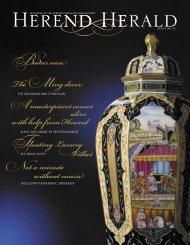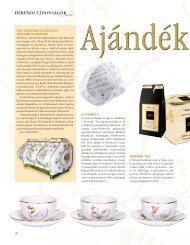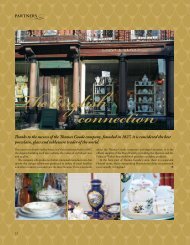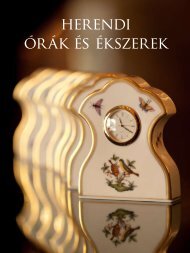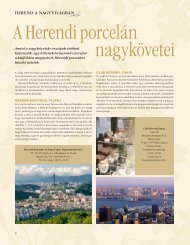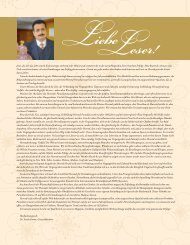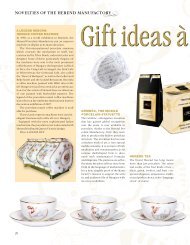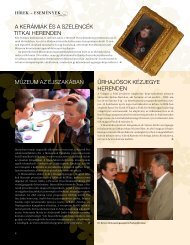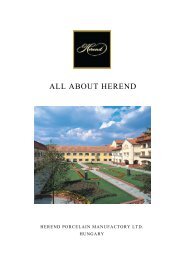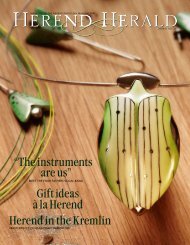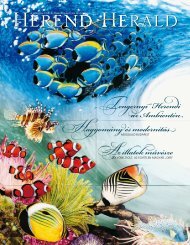LA PORCELAINE DE HEREND HEREND PORCELAIN
Genfi_32 q:Layout 1
Genfi_32 q:Layout 1
Create successful ePaper yourself
Turn your PDF publications into a flip-book with our unique Google optimized e-Paper software.
66 La production de Herend, à sa manière, reflètera cette<br />
évolution, avec ici ou là des créations qui affirment sans<br />
ambages leur caractère national. Comme dans le cas de<br />
cette aiguière monumentale en forme de gourde annulaire<br />
avec un disque central ajouré (N°39). Ce modèle<br />
inspiré des arts populaires autochtones contraste avec les<br />
formules convenues de l’éclectisme international, même<br />
si le peintre a choisi de le rehausser d’un motif d’origine<br />
japonaise (le décor Siang rouge en l’occurrence)! Il est vrai<br />
qu’au-delà de sa lointaine origine, le Siang rouge était<br />
devenu une part intégrante de l’identité même de Herend.<br />
Le plateau montrant l’empereur Joseph II (1741-1790)<br />
sur son lit de mort (N° 41) témoigne du fait que Herend<br />
n’a pas renoncé à ses ambitions, notamment dans le<br />
domaine pictural. Même si – à y regarder de plus près –<br />
le travail du peintre János Seszták n’est pas tout à fait à<br />
la hauteur de ces ambitions…<br />
Avec le décor Tupini (N° 42) – du nom de son premier<br />
commanditaire, un marchand italien – on retrouve l’évocation<br />
de l’âge d’or de la porcelaine et tout l’esprit du<br />
style rocaille, mais dans une formule qui ne manque ni de<br />
fraîcheur ni d’imagination, du moins en ce qui concerne<br />
les motifs peints. Les formes font écho à des prototypes<br />
germaniques, tandis que le plateau à bord ajouré n’est<br />
pas sans rappeler le Plateau losange produit à Sèvres<br />
dans les années 1760-70.<br />
Tout aussi inventif, le décor Kyoto qui rehausse le vase<br />
N° 43. Le galbe du récipient et la prise du couvercle en<br />
forme de lion Fô rappellent certes les porcelaines d’Arita<br />
de la fin du XVII e siècle, généralement décorées en bleu<br />
sous couverte ou dans la palette Imari, mais le décor<br />
peint est apparemment une création de Herend.<br />
Herend‘s production reflected these changes in its own<br />
way, with pieces created now and then that were unambiguously<br />
national in character. This is the case with this<br />
monumental pitcher shaped like a ring gourd with a<br />
central openwork disk (No. 39). This model, inspired by<br />
native folk-art, forms a contrast to the conventions of<br />
international eclecticism, even though the painter has<br />
chosen to embellish it with a motif of Japanese origin<br />
(the Siang rouge pattern in this case)! It is true that<br />
notwithstanding its distant origins, the Siang rouge pattern<br />
had become an integral part of the Herend identity.<br />
The tray showing Emperor Joseph II (1741-1790) on his<br />
deathbed (No. 41) illustrates the fact that Herend had<br />
not abandoned its ambitions, especially on the pictorial<br />
side. Even if the work of painter János Seszták – when<br />
looked at more closely – is not quite equal to those<br />
ambitions…<br />
With the Tupini pattern (No. 42) – named after the<br />
person who first commissioned it, an Italian merchant –<br />
we again find an evocation of the golden age of porcelain<br />
and the whole spirit of the rococo style, but in a<br />
design that lacks neither freshness nor imagination, at<br />
least as far as the painted motifs are concerned. The<br />
shapes echo German prototypes, whilst the tray with its<br />
openwork edging recalls in some respects the Plateau<br />
Losange produced at Sèvres in 1760-70.<br />
Equally inventive is the Kyoto pattern decorating vase<br />
No. 43. The curved body of the vase and the lid grip in<br />
the shape of a Fo lion are certainly reminiscent of Arita<br />
porcelain at the end of the 17th century, which was generally<br />
decorated in underglaze blue or in Imari colours,<br />
but the painted pattern is apparently a Herend creation.<br />
67<br />
Les exemples N° 44 et 45, véritables démonstrations<br />
de maîtrise technique avec leurs fleurs délicatement modelées<br />
et appliquées, renvoient de nouveau à Meissen.<br />
Par contre, l’idée de former une lettre au moyen des<br />
fleurs de porcelaine est, semble-t-il, plutôt inédite. La<br />
forme de la corbeille est empruntée au patrimoine de la<br />
grande manufacture saxonne: le prototype y fut créé par<br />
Kändler vers 1765-70 15 ; le modèle sera réactualisé par<br />
Ernst Leuteritz vers 1850. Le modèle saxon est muni de<br />
quatre pieds en forme de branches et d’anses obliques.<br />
Nos. 44 and 45, real demonstrations of technical mastery<br />
with their delicately modelled and applied flowers,<br />
are again evocative of Meissen. But the idea of forming<br />
a letter from porcelain flowers is apparently quite original.<br />
The shape of the basket is borrowed from the<br />
heritage of the great Saxon manufactory: the prototype<br />
was created there by Kändler around 1765-70 15 ; the<br />
model was updated by Ernst Leuteritz around 1850. The<br />
Saxon original has four feet in the form of branches and<br />
loops at oblique angles.<br />
36<br />
Plat, vers 1890<br />
Scène aquatique, marli ajouré<br />
à la manière de Meissen<br />
diam. 52 cm<br />
Marque estampée: <strong>HEREND</strong><br />
HPMA, inv. 66.285.1<br />
Le service à café N° 46 reste dans la veine éclectique,<br />
mais avec plus de créativité. Une combinaison inédite<br />
et assez subtile d’éléments stylistiques occidentaux<br />
(toujours le néo-rococo) et levantins (par exemple le bec<br />
verseur de la cafetière).<br />
(RB)<br />
The coffee service (No. 46) is still in the eclectic vein, but<br />
with more creativity. An original and rather subtle combination<br />
of (still neo-rococo) western and near-eastern<br />
stylistic elements (for example the spout of the coffee<br />
pot).<br />
(RB)<br />
Dish, ca. 1890<br />
Waterlife scenery with birds and fishes.<br />
Openwork in the manner of Meissen<br />
Diam. 52 cm<br />
Impressed mark: <strong>HEREND</strong><br />
HPMA, inv. 66.285.1<br />
14<br />
Le motif est connu sous la dénomination Brühlsches Allerlei:<br />
Ulrich Pietsch (éd.), Schwanenservice. Meissener Porzellan für<br />
Heinrich Graf von Brühl, Dresde, 2000, pp. 208-209; Herend<br />
en donnera d’ailleurs une première version très fidèlement<br />
imitée: Balla 2003, p. 57<br />
15<br />
Rückert 1966, N° 713<br />
14 The motif is known as Brühlsches Allerlei: Ulrich Pietsch (éd.),<br />
Schwanenservice. Meissener Porzellan für Heinrich Graf von<br />
Brühl, Dresden, 2000, pp. 208-209; Herend in fact produced a<br />
first, very faithful version: Balla 2003, p. 57<br />
15<br />
Rückert 1966, N° 713



